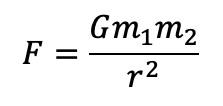Force of Gravity
Newton’s three laws of motion describe how forces cause objects to accelerate or decelerate. One everyday force that you are likely already familiar with is the force of gravity. Isaac Newton also published an equation that describes the way that two massive objects are attracted to each other via the force of gravity:

… where G is the universal gravitational constant ( 6.7 * 10-11 m3 kg-1 s-2 ), m1 and m2 are the masses of the two objects in kilograms, r is the distance between the centers of the two objects, in meters, and F is the resulting force, in Newtons. For example, if you weigh 60 kg and are currently on Earth’s surface (which is 6,378,000 meters away from Earth’s center), then you are currently experiencing 590 Newtons of gravitational force from the Earth, given that the Earth has a mass of 5.972 * 1024 kg. Since we know from Newton’s second law that F = m a , we can also calculate what your acceleration due to Earth’s gravity would be if there were no ground for you to stand on. Your acceleration would be 9.8 m/s2, which is true for all objects that fall at or near Earth’s surface. Note that this constant changes as you go further and further from Earth’s center of mass.